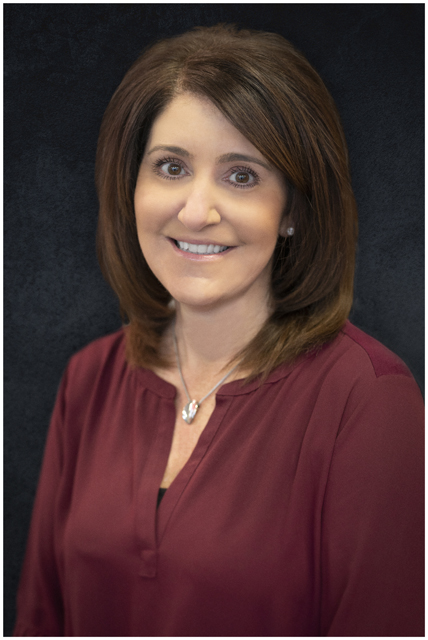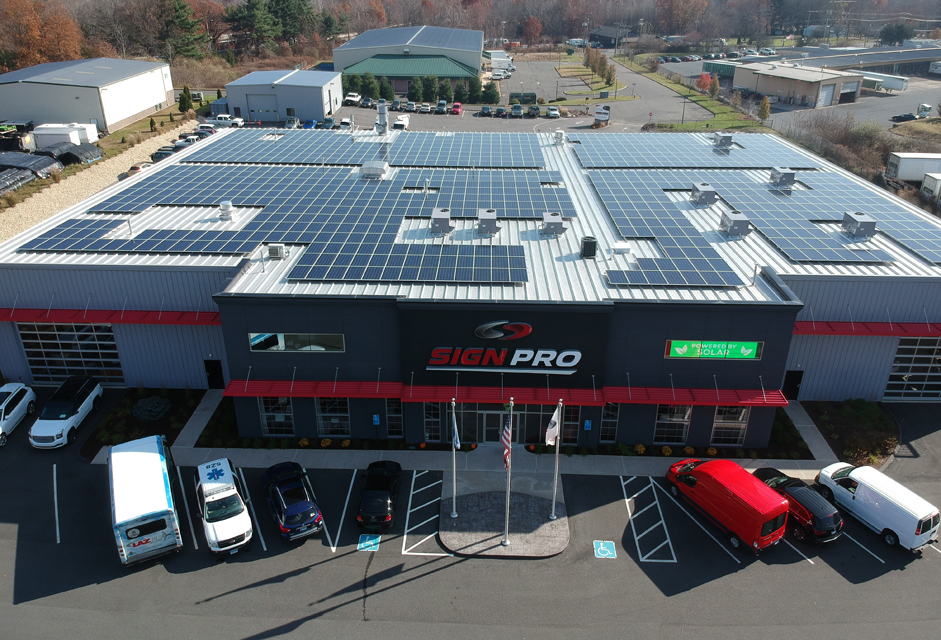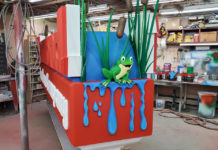
Suzanne Rappoccio is Vice President of Administration at Sign Pro, Inc., a family-owned sign manufacturing company based in Plantsville, Connecticut that currently employs seventy-plus employees. In addition to overseeing payroll, receivables, 401K and insurance plans, vehicle records, vital documents, and employee issues, Suzanne has also played an instrumental role in mid-March developing and establishing a successful business continuity plan during the COVID-19 pandemic outbreak.
But let’s back up for a moment. Suzanne started her professional career as a paralegal working for a senior partner in a Hartford-based law firm when her husband Peter started up Sign Pro, Inc., thirty years ago. During this time, she also helped her husband at nights dealing with paperwork before making the decision seven years ago to go full-time with the sign company.
It truly is a family affair at Sign Pro, as Peter and Suzanne’s two sons (one a student at the University of Connecticut and the other in high school) also help out during school breaks and the summers. “My biggest challenge is separating my work life from my personal life,” she says. “It’s difficult not to talk shop at home during family dinners, and it’s not uncommon to have sign-related conversations with our kids out at events.”
Peter and Suzanne also view their employees as part of their family and do as much as they can to help enrich their work and personal lives. Last year, they welcomed Connecticut Governor Ned Lamont to their 45,000-square-foot facility to discuss items made by manufacturers in the state. This past February, the sign manufacturer played host to state Chief Manufacturing Officer Colin Cooper, along with representatives from the CT Business and Industry Association, the Greater New Britain Chamber of Commerce, the New Haven Manufacturing Association, and the CT Department of Labor to discuss opportunities for collaboration in order to address challenges shared by manufacturers in the state.
Community has also long played a role at Sign Pro, Inc. “We’re very fortunate to be in a position where we’re able to give back to the community—whether it’s sponsorships, monetary donations, signs, or banners for local schools, sports teams, or non-profits. Whatever and however we can give back, we do.”
Suzanne, like Pete, is the “face” of the business in the community, as she oversees the company’s social committee hosting events. “We try to do things that make good community and business sense,” she says.
Among Suzanne’s recent accomplishments include creating a cross-functional team consisting of a Senior Leadership Team and a Core Leadership Team to address profits and productivity across the organization.
Sign Builder Illustrated recently spoke further with Suzanne about some of successful recent actions she has helped implement at her company, as well as her proactive work at quickly developing a business continuity plan during the initial stages of the COVID-19 outbreak (all of which can serve as inspiration to other sign companies out there).
SBI: Please tell our readers more about the cross-platform teams you created late last year.
Suzanne: We used to only have a Senior Leadership Team, which was made up of Peter, myself, our CFO, and our production director. But as our business transitioned, so too did our structure. So back in December, we also formed a Core Leadership Team to work with the Senior Leadership Team to address profits and productivity across our company. The Core Leadership Team reports to the four of us on the Senior Leadership Team, as we deal together with issues.
How did the two teams work together during the outbreak of the COVID-19 pandemic?
Suzanne: We met on March 13 where both teams provided feedback about the different areas of our company—production, sales, project management, safety, construction management, administrative, and the front end of our Sign Pro Express business component. We have so many opportunities on so many different platforms, so we were trying to find a way to consistently manage information as it comes in. But we needed to come up with emergency preparedness training to help us.
So we had a meeting at three o’clock to discuss things. I was straightforward with everyone. I didn’t really know what the best plan was, but I knew we had the resources here to be able to pull this together and focused on those.
We first had to identity the people who are core to our business continuity—the essential staff that we needed to have here on-site in production and in the office in order to maintain business continuity. Then from that list, we identified who we could have work remotely as quickly as possible.
We have a good infrastructure from the start to build on and pull from to construct a plan. I think because the organization developed this Core Leadership Team in support of the Senior Leadership Team, we had two levels of management with the same story instantaneously.
We have continuously evolved over the thirty years in business, so this allowed our employees to act swiftly and jump onboard and do what it takes to address this critical issue.
We were able to draft a plan to use as a template by six o’clock and started executing it the next day. I made announcements to our employees and informed customers on our Web site and through social media, describing our approach to the business continuity plan. We have been updating the plan ever since as a continuous document.

What are some of the things this Business Continuity Plan encompassed?
Suzanne: Some of the core things in this business continuity plan we addressed from the start including defining the purpose of the plan—which is to essentially to focus on prevention, protection, risk mitigation, and response and recovery. We wanted to keep this plan reasonable, rational, and responsible from an employer perspective, an employee perspective, [I]and[I\] a customer perspective.
The plan also involved informing employees and customers related to the work schedules we implemented. We also set up Virtual Private Network (VPN) access for critical employees to work remotely. And we all had to do this all while maintaining customer delivery schedules.
We wanted to identify what critical staff we needed through this process from a business operations perspective and from the production perspective, and we shared that information with everybody.
I am maintaining this plan and providing all communications from within the organization. Doing so prevents rumors flying around. We won’t be at a point where a manager is telling her group one thing and then another manager is telling his group something else.
Were there any unexpected challenges to setting up a work schedule plan?
Suzanne: I wanted to get as many people who could perform their jobs remotely away from the office. But we discovered we didn’t have enough laptops for everybody, so we had to immediately order enough laptops for everybody. Our IT engineer quickly got everyone set up and connected through the VPN to talk with each other. We were able to get as many staff as possible off-premise to work virtually from home.
Are there any other steps you’re taking?
Suzanne: I’m also handling the personal and labor issues associated with this virus and this business continuity plan. We’ve engaged our attorneys so they respectfully address the human resources workforce issues that need to be addressed during this time of uncertainty.
We were also involved on a conference call with other manufacturers discussing with the governor today to find out what the status is of some assistance.
How are you conducting the lines of communication with everyone?
Suzanne: We use all our social media platforms—Facebook, Instagram, and LinkedIn. We also provide information to our customers on our Web site. I’m responsible for reviewing everything before it’s posted or shared so that there is always business continuity in those.
It’s important to let your customers know what you’re doing. We also used MailChimp to reach out to our active database of customers telling them our plans. Within five minutes, we received an order for twenty signs from one of our customers. We didn’t put that message out other than with the intention of educating our customers, but we are in the sign business. That person came in that day and picked up their signs up the same day. They said they would be sharing this with their suppliers as well, which may turn into further phone calls.
What did you learn most after implementing this Business Continuity Plan?
Suzanne: I learned during this whole process we had loyalty from our employees, our customers, and our suppliers. Their willingness to contribute to the solutions were greatly appreciated. The trust that we built between our internal and external customers helped us support each other. And it was a true commitment from the entire organization.
One thing mentioned is that Peter likes to use the phrase, “Giddyup!” and it’s a philosophy ingrained at your company.
Suzanne: Absolutely. This was certainly a case when we put the email out to all our employees and had our sub-group meetings. Everybody really understood and wanted to pitch in unselfishly offering how they could help or asking what they could do or they could from home.
I truly felt that we did pull together as a family and got it done.
—Jeff Wooten










